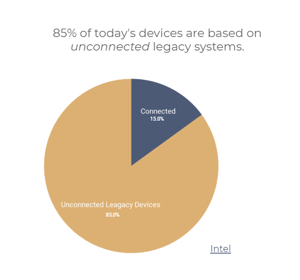The Island of Misfit Devices: Overlooked Equipment in the Digital Age
It’s time to rescue the misfit devices. As we continue to transition from a world of isolated systems to one where everything is connected, many pre-Internet, “outdated” devices are being hung out to dry. Although there are currently 26 million devices connected to the Internet of Things, Intel  estimates that 85% of existing devices are inaccessible and unconnected.
estimates that 85% of existing devices are inaccessible and unconnected.
Over the last several years, the Consumer Internet of Things (CIoT) has evolved quickly, demonstrating the value of connected systems. Devices like smart speakers, doorbell cams, and connected appliances help people automate daily tasks, gain new insights about their lives, and save money through increased efficiency. The Industrial Internet of Things (IIoT) stands to help businesses unlock similar benefits on a larger scale.
Several industries such as healthcare, education, and financial services have started to leverage the IIoT to streamline and digitize their businesses, while other sectors have been slow to react, leaving billions of devices on the proverbial shelf. But before we toss these legacy assets, let’s take a closer at why certain industries are lagging and how smart changes can breathe new life into outdated devices.
Industries Left Behind
Manufacturing equipment on a plant floor— motors, pumps, compressors, cranes, conveyors and hoists—represents a significant investment. Companies spend millions, not only on business capital, but on operations, maintenance and personnel. It’s no wonder then, that when faced with the prospect of spending millions more to “connect” their equipment only 15% of devices used in the machinery industry are currently connected.
The utility industry also relies on an extensive system of legacy equipment, not the least of which is an aging national power grid. Factors such as rising electricity costs, changing load patterns, and regulatory changes have taken time and money away from digital initiatives. Add in geographic separation between devices and you can see why the industry has an IIoT implementation rate of just 18%.
This is not to say that managers in these industries do not see the benefits of the IIoT or want to get connected. In fact, 59% of manufacturing managers worry that they’re already too late to adapt to this new way of operating. What’s needed is an approach that can be implemented incrementally, does not require the rip out and replacement of equipment and is cost effective. Any solution must be able to overcome the following challenges to succeed:
Challenge #1 Uncontrolled Environments
Physical environment for industrial-connected devices can vary widely, from remote plants and factories to mines and substations. Technology installed in these areas must be able to withstand extreme temperatures, inclement weather, and exposure to dust, fumes, and other contaminants. Connections to electric power and network communications might be physically impossible or cost prohibitive so a self-sufficient, battery operated device requiring no existing infrastructure is key.
Challenge #2 Outdated Expertise
Legacy equipment is controlled by highly trained workers who likely have spent many years in the industry. What becomes of these long-time team members who lack the experience to run digital devices? And what skills do employees need in order to keep connected equipment working properly? According to market research firm Vanson Bourne, the top three IIoT-skills that companies believe they lack are security, data science, and tech support. An organization can begin the long process of hiring expensive resources or opt for a solution that is simple, self-contained, and doesn’t require a team of tech experts to deploy and configure.
Challenge #3 Lack of Uniformity
Existing operations typically evolve over a long period of time and have a wide variety of legacy equipment from numerous suppliers. The sheer number of equipment permutations and combinations can make any type of information model in this environment daunting and cost prohibitive. Devices that provide necessary insight to operations without needing to collect “everything about everything all the time” are central to manage a diverse legacy environment
A Sequel for Misfit Devices
In the industrial sector, rip and replace solutions aren’t always viable. But neither does it make sense to leave these legacy devices behind. Connecting legacy devices to IoT platforms and systems enables decision makers access to relevant information to make timely decisions. For example, a decades-old injection molding machine can be equipped with sensors that predict maintenance needs long before they become a more expensive issue, or installing sensors that instantly determine which utility poles have been damaged after a storm can shave hours off power restoration efforts.
It is possible to give legacy devices a second life and many business leaders in manufacturing, utilities and logistics are doing just that. In fact, the "upgrade market" for misfit devices is estimated to account for 22% of the $1.7 trillion current IoT market. More importantly, upgrading these systems costs about 30% of a net-new IoT installation. Companies that have committed to connecting their equipment are generating 15% higher net income than their competitors. They’re also realizing greater resource management, improved efficiency, and an enhanced customer experience. Learn how you can give voice to your misfit devices and take advantage of the benefits of connectivity that impact your bottom line.

